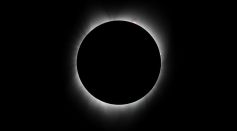Tags: Sun

Unusual Orange Auroras Seen in Scotland After Solar Storm Smashed Into Earth

Almost X-Class-Level Solar Flare Sends Huge Coronal Mass Ejection Towards Earth That Could Hit the Planet, Trigger Geomagnetic Storm
Solar Gravitational Lensing for Power Transmission: Can We Use Sun’s Gravity To Communicate Between Stars?
Cluster of Sunspots 15 Times the Earth’s Size May Send Solar Storm This Weekend
Devil Comet Loses Horns: Unusual Green Hue and Mysterious Shadow Emerge After Violent Outburst
Mars Temporarily Vanishes Behind the Sun; NASA's Robots Operate Autonomously Until Conclusion of Solar Conjunction

Sunspot Unleashes Prolonged Aurora-like Emission in Unprecedented Solar Phenomenon

Beyond the Sun's Glare: Unseen Threats Concealed in Our Cosmic Blind Spot Pose Potential Catastrophe, Astronomers Warn

Spectacular Northern Lights Show Anticipated in Northern US, Following Sun's Magnetic Activity Surge
Solar Activity To Become Stronger As Sun Approaches Maximum Cycle; Northern Lights Will Be More Frequent in 2024

12P/Pons-Brooks Volcanic Comet Reaches Explosive Third in Five Months

Auroras in Texas? Rare Solar Eruptions Paint Southern US Skies with Vibrant Northern Lights

How Old Is Our Sun? How Long Will It Shine?

Infrared Auroras on Uranus Captured For the First Time: New Discovery Offers Clue to the Planet's Puzzling Heat

Northern Lights Extravaganza: More Aurora Displays Expected in the Next Four to Five Years
Sun’s Snake-Like Magnetic Fields Could Potentially Help Answer Puzzling Coronal Heating Problem

Rare Annular Solar Eclipse Best Photos: Citizens Share Spectacular Images of Last Weekend's Eclipse Across the Americas

From 'Ring of Fire' to Total Solar Eclipse: What To Expect From the Upcoming Celestial Meeting Next Year

What To Expect During a Solar Eclipse? 10 Unusual Phenomena to Look Out for This Weekend
NASA's Parker Solar Probe Clocked Historic Speed of Almost 400,000mph Near the Sun
Most Popular

Persistent Coughs Are Everywhere: Here's What Experts Think Is Causing It

Ancient Hotspot Found to Have Created Great Lakes 300 Million Years Ago

Mysterious Structures Discovered Beneath the Pacific Ocean, Puzzle Scientists

Health Benefits of Drinking Hot Chocolate




